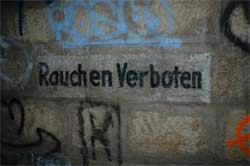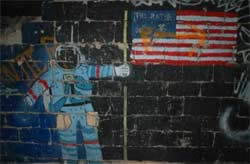
The Paris catacombs are a 300 km (186 mile) network of subterranean tunnels and rooms stretching under Paris in what were Roman-era limestone quarries, hence their official title – ‘les carrières de Paris’, or the quarries of Paris.
Towards the end of the eighteenth century, however, the catacombs were converted into a mass-grave. This was to address the growing spread of disease in the Les Halles district in the middle of the city from improper burials and mass graves in churchyard graveyards, especially the large Cimitière des Innocents. With the cemeteries constrained by the city that had grown up around them, there was often no way to bury bodies other than to put down a layer of earth and keep piling them on top of each other – the ground in some cemeteries had swelled to more than ten feet above the road. Not only did the smell torment local residents, but occasionally the cemetery walls would split open, spilling rotting bodies onto the street, spreading disease. In total, more than six million people were transferred to the catacombs.
Official visits

A small section of the catacombs are open to the public today. These contain hundreds of thousands of human remains, often arranged into decorative patterns where the side vaults meet the main passageway. Often, a marble plaque will describe which cemetery the remains came from and when. Every so often the tunnels will open up into a wider clearing and here various altars and plaques are engraved with quotes that reflect or comment on death and human mortality – Dante is a particular favourite.
The catacomb walls themselves are covered in graffiti dating from the eighteenth century onwards, and the tunnels have played host to a succession of visitors. Victor Hugo, for example, used his knowledge of the tunnel system in Les Misérables. In 1871 communards killed a group of monarchists in one chamber. During World War II, Parisian members of the French Resistance used the tunnel system to escape detection. Also during this period, German soldiers established an underground bunker in the catacombs below Lycée Montaigne, a high school in the 6th arrondissement.
Unofficial visits

It is possible to gain access to the catacombs through certain manhole covers, metro tunnels and sewers – their locations are jealously guarded. People who make use of these access points and illegally enter the catacombs to hold parties or simply explore are known as cataphiles. Things to see include an abandoned Nazi bunker, The Beach (a complex of heavily graffitied chambers with sand-covered floors), a room containing a sculpted castle illuminated by tea lights and the adjoining “castle garden,” where plastic vines and flowers have been draped across stone walls
As an example of the scale of activity taking place in the catacombs, in September 2004 the French police discovered a hidden chamber near the Place du Trocadero. This chamber, essentially an amphitheatre that had been hewn from the surrounding rock, had seemingly been used as an underground movie theatre run by a group called the Perforating Mexicans. The chamber contained a movie screen, and an adjacent chamber contained a well stocked bar, kitchen, phones and Internet access. When the police returned for a formal investigation, all the equipment had disappeared – all that was left was a note on the floor reading, “Do not try to find us.”

However, precautions should be taken before venturing too far underground. The tunnel system is highly complex, and although some tunnels have plaques indicating the name of the street above, it’s easy to get lost – a map (as a minimum) and a guide are recommended. Because of this and the danger of flooding, sudden cave-ins, hidden wells and aging cables and wires, unofficial visits to the catacombs have been illegal since November 2, 1955. Anyone caught by the cataflics (the special police who patrol the catacombs) are subject to a €60 fine.




